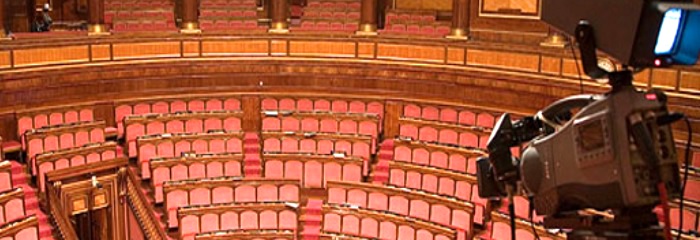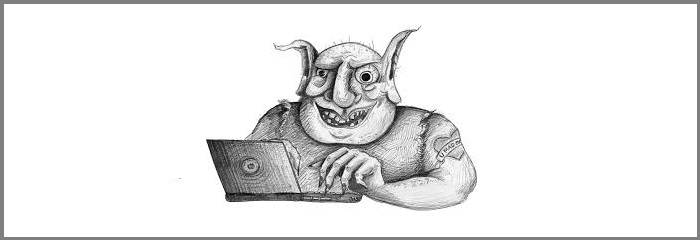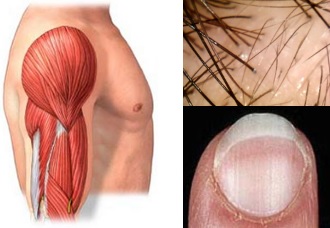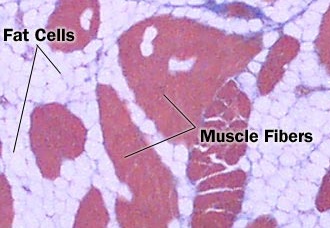Molte persone sono convinte di avere delle opinioni proprie: riguardo la politica, l’economia, la cronaca, lo sport, e via dicendo. Ma in realtà spesso le loro opinioni non sono le loro: sono nate, cresciute, e si sono orientate, sotto la guida scaltra di articolisti di giornali, o produttori di notiziari. Le opinioni della gente vengono fatte ricadere dentro un solco già scavato in precedenza.
 In questo articolo ho deciso di raccogliere alcune tecniche di manipolazione che i media usano per influenzare le masse, tra quelle che io riesco a vedere, e tra quelle che più mi impressionano per quanto sono subdole e dannatamente efficaci. Queste tecniche vengono utilizzate dai media più o meno sempre per gli stessi scopi:
In questo articolo ho deciso di raccogliere alcune tecniche di manipolazione che i media usano per influenzare le masse, tra quelle che io riesco a vedere, e tra quelle che più mi impressionano per quanto sono subdole e dannatamente efficaci. Queste tecniche vengono utilizzate dai media più o meno sempre per gli stessi scopi:
- ricevere attenzione (e quindi soldi tramite pubblicità)
- portare avanti l’agenda di qualche partito politico o corporazione
Naturalmente le persone che vengono influenzate dai media non ne sono mai coscienti -loro pensano di avere opinioni “personali” e “libere”- per cui spero che, se sei vittima di una di queste tecniche di manipolazione, questo articolo possa esserti utile ad accorgertene. Iniziamo dunque con un grande classico:
1. Puntare costantemente i riflettori su personaggi che contano poco
 Un pilastro fondamentale della manipolazione mediatica è tenere al centro della scena, costantemente, personaggi che contano poco. Spesso si tratta di personaggi propensi a fare uscite forti, razziste, sessiste, che generano facilmente indignazione nel pubblico. Questi personaggi, della cui impopolarità i media sono perfettamente coscienti, vengono intervistati frequentemente, e le loro sciocchezze vengono immediatamente riprese da tutti i giornali generando dei “flame” tra la gente, cioè discussioni infuocate.
Un pilastro fondamentale della manipolazione mediatica è tenere al centro della scena, costantemente, personaggi che contano poco. Spesso si tratta di personaggi propensi a fare uscite forti, razziste, sessiste, che generano facilmente indignazione nel pubblico. Questi personaggi, della cui impopolarità i media sono perfettamente coscienti, vengono intervistati frequentemente, e le loro sciocchezze vengono immediatamente riprese da tutti i giornali generando dei “flame” tra la gente, cioè discussioni infuocate.
Dal canto loro, questi personaggi che contano poco sono spesso compiaciuti dell’attenzione ricevuta, e non sono essi stessi coscienti di essere pedine di un gioco molto più grande, un gioco il cui scopo vero è tenere dietro le quinte, lontani dai fari e sconosciuti ai più, i volti e i nomi dei personaggi che contano per davvero: banchieri, lobbisti, capi di corporazioni, e questi di certo si vedono molto meno nei notiziari.
Funziona benissimo: la gente concentra tutto il suo odio e i suoi insulti su personaggi irrilevanti, senza accorgersi che la vita pratica che fa tutti i giorni (sveglia – caffè – di corsa fuori casa – traffico – ufficio – spesa…) dipende invece fortissimamente dalle decisioni di ben altri personaggi, che lontani dai riflettori esercitano il potere indisturbati.
Magari, a volte, anche questi altri personaggi hanno pensieri razzisti o sessisti, ma si guardano bene dal dargli voce in televisione: loro sono abbastanza intelligenti da non fare dichiarazioni che ne potrebbero compromettere l’immagine pubblica, e stanno ben attenti a non sovraesporsi. Preferiscono lasciare i burattini al centro della scena.
2. Puntare costantemente i riflettori su luoghi che contano poco
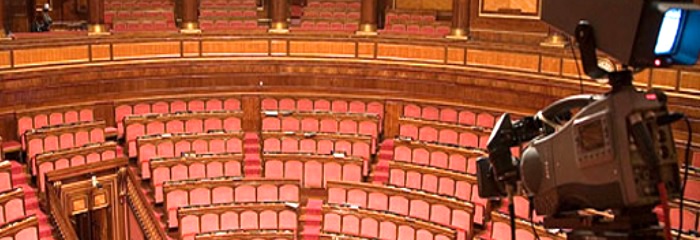 Davvero pensi che sia il parlamento il luogo in cui si prendono le decisioni importanti? Raramente. Le decisioni importanti ormai si prendono in tutt’altri luoghi: in ville private, sui tavolini dei bar, nei ristoranti. E le prendono appunto quei personaggi sconosciuti alla massa, che discutono di accordi miliardari indisturbati dalle telecamere.
Davvero pensi che sia il parlamento il luogo in cui si prendono le decisioni importanti? Raramente. Le decisioni importanti ormai si prendono in tutt’altri luoghi: in ville private, sui tavolini dei bar, nei ristoranti. E le prendono appunto quei personaggi sconosciuti alla massa, che discutono di accordi miliardari indisturbati dalle telecamere.
Nel frattempo i media continuano a dare ampia copertura a quello che succede in parlamento: le votazioni, le dichiarazioni dei politici, le bagarre in aula quando l’opposizione si scalda, i battibecchi su questioni marginali, e via dicendo.
Intendiamoci: in teoria avrebbe davvero molto senso tenere puntata l’attenzione sul parlamento… se il parlamento fosse davvero il luogo dove si fanno le leggi. Purtroppo in pratica, e questo vale per molti governi, il parlamento nella sua globalità è una macchina di una inefficienza mostruosa, che produce una legge ogni morte di papa. Non è questione di destra, sinistra, centro o opposizione: è proprio il parlamento intero che è un organo improduttivo.
E nei pochi casi in cui arriva davvero a produrre una legge, il processo spesso è ben poco democratico. Infatti non c’è nessun dialogo tra le parti: ogni politico si alza, prende il microfono, fa le sue dichiarazioni che gli avversari a malapena ascoltano, e si siede. La scena si ripete a parti invertite. Dopodiché si vota seguendo indicazioni arrivate dall’alto, dai capi delle due fazioni, che spesso non sono nemmeno seduti parlamento, o addirittura non ne fanno parte affatto (lobbisti, banchieri, etc).
In maniera analoga al caso precedente quindi, una seconda tecnica di manipolazione mediatica -efficassima- consiste nel puntare costantemente i fari sul parlamento, suggerendo l’idea che è quello il centro dell’azione, lasciando invece che ai tavolini di un bar, a pochi isolati di distanza, qualcun altro stia decidendo le sorti del paese davanti a un caffè.
3. Inondare blog e giornali online di trolls
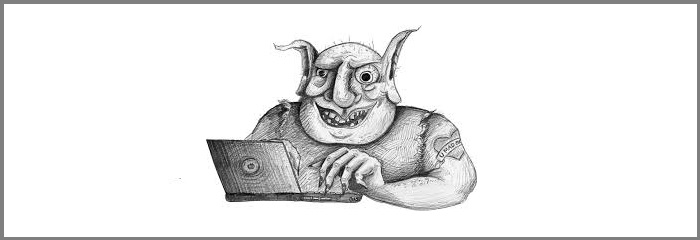 Casomai non foste familiari con il gergo di internet, nell’ambito dei blog e dei siti di notizie online, un troll è qualcuno che commenta un articolo con degli scopi ben precisi: creare divisioni nella comunità, ridicolizzare l’autore, insinuare dubbi tra i lettori, smorzare gli entusiasmi.
Casomai non foste familiari con il gergo di internet, nell’ambito dei blog e dei siti di notizie online, un troll è qualcuno che commenta un articolo con degli scopi ben precisi: creare divisioni nella comunità, ridicolizzare l’autore, insinuare dubbi tra i lettori, smorzare gli entusiasmi.
L’elite che detiene il potere ha capito una cosa: è facile manipolare il pubblico attraverso i vecchi media monodirezionali, come la televisione. Con la televisione la propaganda viene propinata agli spettatori, senza che questi possano fare molto più che assorbirla. Ma è molto più difficile tenere sotto controllo internet. Non solo esiste una varietà enorme di siti di opposizione che diffondono contenuti “scomodi”, ma quegli stessi siti di opposizione permettono uno scambio bidirezionale: gli utenti possono commentare gli articoli, discutere tra di loro, mettersi in contatto. E tutto ciò è estremamente pericoloso per chi detiene il potere.
La tecnica più efficace che hanno trovato per manipolare le persone quindi -anche su internet- è quella di inondare questi siti di trolls. Trolls che, non appena viene pubblicato un nuovo articolo dai contenuti potenzialmente “pericolosi”, si mettono all’opera e lo riempiono di commenti carichi di scetticismo, pessimismo, sarcasmo, o in cui semplicemente insultano gli altri utenti reali creando dei flame, così che se non altro distolgono l’attenzione dal tema originale che veniva discusso nell’articolo.
I trolls sono difficili da identificare, soprattutto perché grazie all’anonimato tipico di internet possono apparire con nomi diversi, e sembrare numericamente molti più di quanti sono in realtà. L’efficacia del loro lavoro si gioca sul fatto che molte persone hanno una tendenza naturale a lasciare che la propria opinione si allinei all’opinione collettiva (o almeno che percepiscono come l’opinione collettiva).
Nonostante ciò, con un po’ di esercizio svilupperete abbastanza fiuto da riuscire a smascherarli con agilità, e a quel punto vi accorgerete anche di quali sono i siti che fanno vera opposizione al sistema, perché solitamente sono proprio quelli in cui l’infestazione dei trolls è più grave.
4. Distrarre il pubblico con i diritti
 I media utilizzano diverse strategie per distrarre il pubblico, portando l’attenzione generale via da tematiche importanti e riposizionandola su tematiche minori. Un buon esempio è il grande risalto che danno ai “diritti”, e di questi un caso popolarissimo sono i diritti delle donne e degli omosessuali.
I media utilizzano diverse strategie per distrarre il pubblico, portando l’attenzione generale via da tematiche importanti e riposizionandola su tematiche minori. Un buon esempio è il grande risalto che danno ai “diritti”, e di questi un caso popolarissimo sono i diritti delle donne e degli omosessuali.
Una parola che spiega estremamente bene questa tecnica è il pinkwashing, cioè il lavaggio del cervello “rosa” che viene effettuato sul pubblico ad opera di governi e corporazioni. I media sono pieni di esempi di pinkwashing: prodotti alimentari che sponsorizzano la ricerca per il cancro al seno, interviste a politici che ripetono come un mantra l’importanza dei matrimoni gay, paesi che promuovono il turismo LGBT e facilitano eventi come il gay pride.
Tutte ottime cause naturalmente… se non fosse che questi governi e corporazioni spesso sono così tanto amichevoli nei confronti delle donne e degli omosessuali più che altro per convenienza (dopotutto è una strategia che costa poco e che dà ottimi risultati in termini di reputazione), ma soprattutto se non fosse che mentre come facciata sono così sensibili ai problemi delle categorie interessante, dietro le quinte adoperano delle pratiche orrende, che vanno dal “poco etico” al “criminale”.
Infatti, da una parte una corporazione alimentare sottolinea l’importanza della prevenzione nella salute delle donne, dall’altra dietro le quinte riempie i propri snack di additivi chimici che danno assuefazione (spesso cancerogeni tra l’altro…) e utilizza modelli di mercato distruttivi per l’ambiente. Da una parte un governo trasmette in televisione frequenti spot pro-gay e in nome dell’uguaglianza, dall’altra dietro le quinte colonizza territori stranieri e pratica la segregazione razziale. E così via.
C’è una forte componente emozionale, quella di donne e omosessuali, che viene sfruttata per manipolare il pubblico. Tra le persone che appartengono a queste categorie, che spesso storicamente sono state svantaggiate, e che più frequentemente sono state vittime di abusi, c’è un forte desiderio di validazione. E chi controlla i media l’ha capito bene: fornisce questa validazione battendo in continuazione il tasto dei loro diritti, per poi poter calpestare i diritti di molte altre categorie senza troppe interferenze.
5. Distrarre il pubblico con problemi insignificanti
 Una seconda tecnica che i media usano per distrarre il pubblico è discutere problemi insignificanti, e tra questi un caso che mi piace citare spesso è quello dell’abbandono dei cani.
Una seconda tecnica che i media usano per distrarre il pubblico è discutere problemi insignificanti, e tra questi un caso che mi piace citare spesso è quello dell’abbandono dei cani.
In Italia è un grande classico, che viene riproposto a ogni estate. Stando allo spazio riservato a questo “problema” nei notiziari nazionali, sembrerebbe che ogni anno le autostrade del paese siano percorse su e giù da migliaia di persone crudeli, a caccia di un palo a cui legare il proprio animale. L’idea è ridicola, ma purtroppo funziona molto bene perché sfrutta la componente emozionale di molti appassionati di animali domestici.
Naturalmente, siamo tutti d’accordo che abbandonare un animale domestico è una pratica odiosa, ma dare tanto risalto a questo tema, che numericamente è irrilevante, significa togliere spazio alla possibilità di mostrare problemi veri, ben più impattanti la vita delle persone.
Purtroppo il metodo funziona, e il risultato è tragico e comico allo tesso tempo: mentre il sistema bancario parassitico causa disoccupazione e debiti, mentre in medio oriente migliaia di persone vengono brutalmente torturate e uccise, mentre esiste un’epidemia di problemi legati allo stile di vita, come depressione e intolleranze alimentari… gli spettatori di notiziari e i lettori di giornali si arrabbiano e si commuovono per l’abbandono dei cuccioli.
6. Demonizzare la vera opposizione
 Le istituzioni che detengono il potere si servono dei media mainstream per neutralizzare i veri oppositori, quelli che denunciano gli abusi e che iniziano a guadagnare abbastanza consenso da rappresentare una seria minaccia, usando una strategia semplice ma certamente efficace: dargli poco spazio, e quando gli si dà spazio, buttargli fango addosso.
Le istituzioni che detengono il potere si servono dei media mainstream per neutralizzare i veri oppositori, quelli che denunciano gli abusi e che iniziano a guadagnare abbastanza consenso da rappresentare una seria minaccia, usando una strategia semplice ma certamente efficace: dargli poco spazio, e quando gli si dà spazio, buttargli fango addosso.
Poco importa che un politico, attivista, giornalista, filosofo, abbia un passato irreprensibile. Se viene identificato dal sistema come persona scomoda, ci sono mille modi diversi di dipingerlo nei media facendolo apparire come estremista, disonesto, immorale, pazzo.
Basta riprendere un lungo discorso tenuto dall’oppositore, magari della durata di ore, e da quel discorso estrarre una singola frase che può essere equivocata, per poi sbatterla su tutti i giornali e discuterla in tutti i notiziari. E in termini semplicemente di immagini, l’oppositore può partecipare a un evento pubblico e parlare quasi sempre con espressione rilassata, ma dalle registrazioni di quell’intervento i media possono comunque estrarre un singolo fotogramma in cui l’oppositore ha fatto una smorfia, o un’espressione corrucciata, e piazzarla in prima pagina con un titolo insinuante.
Naturalmente, se il personaggio in questione non ha un passato irreprensibile diventa tutto più facile. Non mi stupirei affatto di scoprire che alcuni governi, o vari gruppi di potere, abbiano messo su degli interi uffici dediti a cercare errori fiscali degli oppositori, a tentare di intercettarli telefonicamente, e in generale a scavare a caccia delle loro magagne. Se hanno fatto il minimo errore, quasi sicuramente prima o poi verrà fuori e verrà sbandierato nei media.
7. Dare spazio alla finta opposizione
 Chi controlla i media sa bene che di opposizione c’è bisogno, almeno una.
Chi controlla i media sa bene che di opposizione c’è bisogno, almeno una.
Molte persone “nella massa” spesso non riescono a vedere le cause principali di molti dei loro problemi (es. la natura parassitica del sistema bancario, le corporazioni che incoraggiano il consumismo, il governo che lavora per sé stesso e le lobbies anziché per i cittadini), ma questo non toglie che riescano a sentire il dolore conseguente a queste cause: la frustrazione dovuta alla mancanza di tempo libero, la noia/stress dovuti a lavori insignificanti, l’infelicità dovuta a troppi oggetti e a troppe poche relazioni umane.
L’elite che detiene il potere capisce bene che questo sentimento negativo ha bisogno di una valvola di sfogo, altrimenti ci sarebbe davvero una rivoluzione che cambierebbe il sistema. E allora gliela fornisce, mettendo però in piedi un’opposizione fasulla.
Il che non richiede certo un gran lavoro: esistono molti personaggi che spontaneamente calzano bene il ruolo dei finti oppositori, basta tenerli frequentemente sotto gli obiettivi delle telecamere. Politici che nelle interviste si dichiarano contrari all’operato del governo (e poi dietro le quinte ci fanno accordi) o politici che davvero sono contrari all’operato del governo, ma hanno delle personalità e idee talmente bizzarre che quasi riescono a far riconsiderare i partiti principali di governo come “il male minore”.
8. Dare nomi positivi alle schifezze
 Un’altra classica tecnica di manipolazione, usata tantissimo nei media, è tutta basata sul linguaggio: si utilizzano nomi a cui istintivamente la gente associa una connotazione “positiva” per chiamare dalle gran schifezze fatte dalle corporazioni e dal governo.
Un’altra classica tecnica di manipolazione, usata tantissimo nei media, è tutta basata sul linguaggio: si utilizzano nomi a cui istintivamente la gente associa una connotazione “positiva” per chiamare dalle gran schifezze fatte dalle corporazioni e dal governo.
Un semplice esempio, di cui ci si può accorgere più facilmente, sono gli spot commerciali in televisione (nota, per capire se un prodotto/servizio è spazzatura potete applicare questo criterio semplice ma praticamente infallibile: se lo pubblicizzano in televisione allora è spazzatura). Esiste una varietà enorme di snack pieni di coloranti, conservanti, e rifiuti tossici vari, i cui nomi contengono le parole special, happy, diet, light, natural.
Però ci sono altri esempi di manipolazione di più alto livello, tra cui molte manovre fatte dal governo, che non sono altrettanto evidenti per il pubblico. Azioni di guerra in paesi stranieri e occupazione militare diventano missioni di pace. Aumenti delle tasse vengono inclusi in piani per la ripresa o decreti sblocca-Italia. L’istituto per il monitoraggio fiscale viene chiamato equitàlia. E soprattutto c’è lei, la parola insensata che intasa i notiziari e viene ripetuta ovunque nei media come fosse un mantra: la crescita.
Leader politici e di corporazioni continuano ripetere ovunque l’importanza di avere crescita economica, e il pubblico spesso non si accorge di cosa davvero si nasconde dietro questo messaggio, proprio perché spesso alla parola crescita si associa qualcosa di buono.
La realtà è che perseguire la crescita infinita -dell’economia, della produzione, della popolazione- su un pianeta con risorse finite è insensato e pericoloso. Sarebbe più sensato, secondo me, parlare di sviluppo, ma questa parola nei media non si sente quasi mai. Il motivo per cui i leader della politica e delle corporazioni insistono invece con la crescita economica è che la crescita genera tasse, e le tasse pagano appunto lo stipendio ai politici stessi (che poi ridistribuiscono a cascata i soldi alle corporazioni “amiche”), e gli permettono di fare quello che vogliono fare.
Lascia che le tue opinioni siano davvero le tue
Si possono discutere parecchie altre tecniche, ma queste che ho appena descritto in questo breve elenco sono sicuramente tra quelle che io “sento” di più, e contro cui considero più utile tenere alta la soglia dell’attenzione.
A me sembra di scorgere gli effetti della manipolazione mediatica in molte persone, in cui appunto noto l’abitudine a parlare rigurgitando opinioni altrui, piuttosto che dando voce all’opinione propria.
 Il metodo migliore per non cascarci, e per non lasciar cadere la propria opinione nel solco pre-confezionato e pre-scavato dai media è applicare il pensiero critico. Non credere a una storia o una notizia semplicemente perché ci credono tutti, o perché la fonte è una autorità. Rendersi conto che molti media sono perennemente a caccia di attenzione (“attention whores“), e che di conseguenza pubblicano intenzionalmente molte notizie che suscitano reazioni forti -rabbia, indignazione, eccitazione- proprio con l’obiettivo di catturare il pubblico.
Il metodo migliore per non cascarci, e per non lasciar cadere la propria opinione nel solco pre-confezionato e pre-scavato dai media è applicare il pensiero critico. Non credere a una storia o una notizia semplicemente perché ci credono tutti, o perché la fonte è una autorità. Rendersi conto che molti media sono perennemente a caccia di attenzione (“attention whores“), e che di conseguenza pubblicano intenzionalmente molte notizie che suscitano reazioni forti -rabbia, indignazione, eccitazione- proprio con l’obiettivo di catturare il pubblico.
E naturalmente chiedersi sempre, ogni volta che si ascolta un notiziario o si legge un giornale, se l’intenzione di chi sta diffondendo quella notizia è davvero mostrare dei fatti inalterati per informare il pubblico… o se invece l’intenzione è manipolarlo, per motivi di comodo.
Note:
Relativi: Che cos’è il “sistema”?, Come liberarti dal sistema



